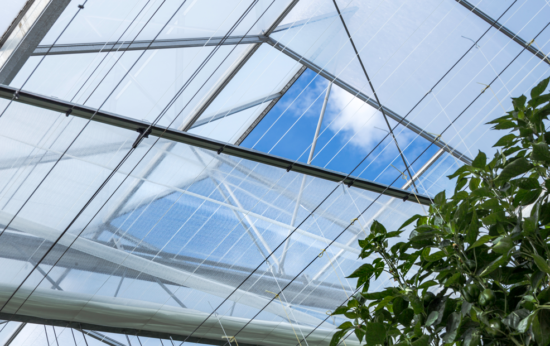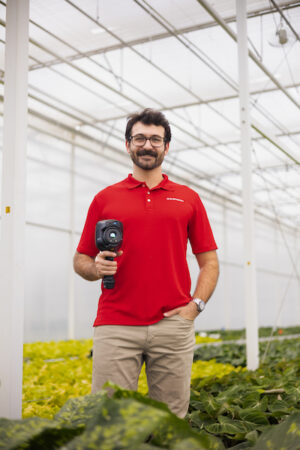
Brought to you by Ludvig Svensson
Enhancing crop quality and energy savings with climate screens
January 8, 2024 in News
The success of a greenhouse-grown crop relies on a delicate balance of the right factors, including temperature, humidity levels and light. Like a good recipe, these elements require a precise and customized strategy to ensure a high-yielding and profitable crop. Too much (or too little) of one ingredient throws off the whole formula.
Technology and equipment advancements spanning several decades have made it easier for growers to fine-tune their success strategies, and necessity continues to drive innovation. Take climate screens, for example. From a simple screen first launched during the energy crisis of the 1970s, climate screens have evolved in function and capability, and have become increasingly popular thanks to their ability to manage temperature, humidity and light levels in a greenhouse, all while proving to save on energy costs.
“Screens help growers maintain optimal environmental conditions and stabilize humidity in greenhouses,” explains Gretchen Schimelpfenig, an energy engineer who works with growers to determine best practices for energy efficiency and decarbonization. As the executive director of Cornell University’s Greenhouse Lighting and Systems Engineering (GLASE) consortium, and a senior energy engineer at Energy Resources Integration (ERI), Schimelpfenig helps growers understand what type (or types) of screens will work best to meet their individual operation’s needs.
Optimizing cold-climate conditions
Climate screens have become somewhat commonplace for floriculture and horticulture crops alike thanks to the role they play in promoting faster plant growth and development and improving plant quality, but they’ve proven to be especially useful in cold-climate regions.
“Thermal screens act like a winter coat, providing a barrier between the greenhouse covering and the plant canopy,” Schimelpfenig says. “Greenhouses often use single-layer coverings like glass or polycarbonate, and these materials transfer heat very well, which is a disadvantage for growers located in cold climates. Screens enhance energy efficiency of heating systems by retaining heat at the plant canopy and reducing heat loss through greenhouse coverings.”

To help growers determine which climate screen is best for their greenhouse, Svensson offers consultancy support from climate advisors to provide customized advice. For example, growers who want to prioritize energy savings and maximize light transmission may choose a Luxous screen, shown here. Photo courtesy of Ludvig Svensson.
Schimelpfenig says the biggest energy benefit is reduced thermal losses. “Eighty per cent of greenhouse heating occurs at night, and thermal curtains provide an insulating barrier that reduces radiative heat loss,” she notes.
With many growers in colder climates relying on supplemental lighting during periods of low daylight in the fall and winter seasons, finding the right combination of light for optimum plant growth and development, while still managing humidity levels in the greenhouse, can become a challenge.
“Transparent thermal screens are preferred for vegetable growers in northern climates to maximize daily light integral,” Schimelpfenig says, referring to the optimal amount of light for a particular plant.
But, the additional heat accumulating in the greenhouse can introduce humidity problems, according to Paul Arena, greenhouse climate consultant for Ludvig Svensson, a manufacturer of climate screens.
“When it comes to gapping, we’ll tell growers anything more than a five per cent opening will lose 50 per cent of the heat you’re trying to save with the energy-saving screen. For colder-climate growers, we also advise maximum light transmission screens, so we’ll offer screens that have lower shade values that can accommodate for wintertime light levels.”
For maximum flexibility when it comes to controlling the greenhouse environment, Schimelpfenig recommends double screening – implementing two different types of screens to perform different functions.
“Colder climates benefit from two screens to maximize light while minimizing heat loss. The first thermal screen can save 25 to 35 per cent heating energy. The second thermal screen can act as a shade or blackout curtain and save an extra 15 to 20 per cent in energy use,” she adds, noting that screens can also be installed on side walls to prevent light leaks.
“Double screening allows growers to be more flexible in controlling the amount of light, humidity and temperature in the greenhouse,” Arena adds, pointing to Svensson’s PARperfect double-screen solution, which combines a blackout or high-shade screen above a low-shade, high-diffusion screen. The position of the screens can be adjusted depending on the intensity of the sunlight, which means each part of the plant receives consistent levels of light in all seasons and conditions. “Because this is a diffusion screen, it’s spreading light evenly across the greenhouse without creating any shadowy lines,” he says. “Instead of having a 20 per cent shade screen, you have now the flexibility to shade between 20 per cent and 100 per cent.”
Double screening may also be helpful for growers contending with light abatement regulations, Arena notes, as a blackout shade can be added to a transparent thermal screen to minimize the amount of light emitted from the greenhouse.
Calculating success
To determine which screen to select, Schimelpfenig says growers should consider the following factors.
“Covering affects transmissivity and shading characteristics. If you’ve already got a double-layer covering, or you have recently constructed a very well-sealed greenhouse, the energy savings might not be as high because you already have less heat transfer happening,” Schimelpfenig adds. “The crop that’s being grown impacts the target level of climate screen transparency. Ventilation in the greenhouse affects how airflow should move through the screen and impacts selection of open-weave or closed-weave screens. Heating and cooling systems, and how humidity is managed, should also be kept in mind as that will influence the choice of fabric weave as well.”

Paul Arena, a greenhouse climate consultant at Ludvig Svensson, helps growers determine the best screening strategies for their greenhouse. Photo courtesy of Ludvig Svensson.
Arena adds the importance of considering any greenhouse infrastructure already in place, like types of lighting, heat pipes and other things that take up space in the trusses of the greenhouse. “During discussions with a grower that already has lights implemented, we take into consideration whether LED or HPS lights are being used. Our energy calculator estimates the amount of heat emitted from the lights, so [the grower wouldn’t] have to run as much heat from the heat pipe. In consideration of that output, there’s also added energy savings because the climate screen is keeping that heat in,” Arena says.
Svensson offers a checklist to help growers determine which climate screen would be best-suited for their greenhouse based on their priorities. “We help growers determine, based on their input, the best screen or screen combination to use,” adds Dustin Mater, Svensson’s Canadian sales manager. “For example. If energy savings and high light transmission are most important, our Luxous line might be a good fit.”
But the support doesn’t stop there. Svensson also provides consultancy and monitoring services for growers to take advantage of Svensson’s Climate House which gives growers insight into their internal climates and pairs growers with an experienced climate advisor who can provide customized advice based on their unique greenhouse.
And like any investment, ROI is a major deciding factor. “[With climate screens], heating costs can be reduced by up to 50 per cent for greenhouses in northern regions with cooler nights and harsh winters,” Schimelpfenig says, with Arena adding that a double screen can provide 60 per cent energy savings with a two-year return on investment (ROI).
To get an accurate view of savings and payback period, it’s important to track energy consumption on an annual basis to determine trends over time, and using ROI tools like Svensson’s energy calculator.
“For example, before installing a climate screen, evaluate heating energy used per square metre of plant canopy or heating energy used per kilogram of plant material produced. This way, improvements in yields and reductions in energy use can be calculated and results can be proven,” Schimelpfenig notes.
When working with clients, Arena also factors in data like local climate radiation levels, gas prices and energy costs, greenhouse dimensions and growing practices among other variables, to provide customized suggestions to growers. “It’s necessary to have all of these inputs for an accurate calculation to determine what screens would be best for a greenhouse,” he says.
“We also factor in yield and profits – with screens, growers can create a more balanced environment within their greenhouse to promote their crops’ healthy growth . . . and you see results in a high-quality crop. That needs to be included in the ROI conversation.”
For more information, visit ludvigsvensson.com/en/climate-screens.
Created by Amplify by Annex, in partnership with Ludvig Svensson and Greenhouse Canada.
Advertisement
- A Berry Good Season: Growtec, MJ-Tech and Partners Reflect on Another Year Transforming the Greenhouse Industry in Canada – and Beyond
- Embracing Efficiency and Maximizing Returns: The Power of Compressed Horticultural Substrates